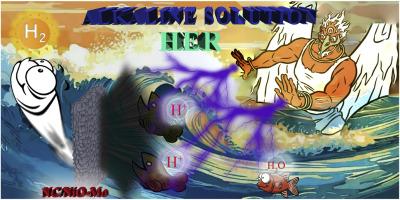In situ synthesis of Ni, Mo bimetallic crystalline-amorphous co-existing heterostructures for efficient hydrogen evolution reaction
IF 14.2
1区 材料科学
Q1 ENGINEERING, MULTIDISCIPLINARY
引用次数: 0
Abstract
Electrocatalytic hydrogen production is a green and feasible method for obtaining hydrogen energy. However, the bottlenecks of high cost, low catalytic activity and inferior stability urgently need to be addressed, and constructing advanced catalysts with optimized microscopic morphology and crystal structure is a feasible and effective strategy to overcome this barrier. Herein, an artful strategy of in-situ grown coupled with N doping and C encapsulation was employed to obtain the NC/NiO–Mo/NF with biomimetic cattle stomach-liked porous structure, which can offer shortcut for ion transportation and expose more active sites for H∗ adsorption. Particularly, the constructed NiMoO4–NiO heterojunction in NC/NiO–Mo/NF can significantly boost the hydrogen evolution activity. Meanwhile, the density functional theory (DFT) confirm that the construction of the crystalline-amorphous heterojunction induces electron transfer from NiMoO4 to NiO, promoting a downshift in the d-band center, thereby achieving a near-thermoneutral free energy for the hydrogen evolution reaction (HER). The de-signed electrocatalyst exhibits exceptional HER activity, with a small overpotential of 48 mV to achieve a current density of 10 mA cm−2. It is important that NC/NiO–Mo/NF exhibits exceptional HER stability, with current density of 50 mA cm−2 for 100 h. The finding provides a feasible strategy for the fabrication of nonprecious-metal-based HER electrocatalysts with high activity and stability toward industrial water electrolysis.

原位合成Ni, Mo双金属晶-非晶共存异质结构的高效析氢反应
电催化制氢是一种绿色可行的获取氢能的方法。然而,成本高、催化活性低、稳定性差等瓶颈亟待解决,构建具有优化微观形貌和晶体结构的先进催化剂是克服这一障碍的可行有效策略。本文采用原位生长+ N掺杂+ C包封的巧妙策略,获得了具有仿生牛胃样多孔结构的NC/ NiO-Mo /NF,为离子运输提供了捷径,并暴露了更多的H *吸附活性位点。特别是在NC/ NiO-Mo /NF中构建的NiMoO4-NiO异质结可以显著提高析氢活性。同时,密度泛函理论(DFT)证实,晶-非晶异质结的构建诱导电子从NiMoO4向NiO转移,促进d波段中心的下移,从而实现析氢反应(HER)的近热中性自由能。设计的电催化剂表现出优异的HER活性,具有48 mV的小过电位,电流密度为10 mA cm−2。重要的是,NC/ NiO-Mo /NF表现出优异的HER稳定性,电流密度为50 mA cm - 2,持续100小时。该发现为制造具有高活性和稳定性的非贵金属基HER电催化剂提供了可行的策略,用于工业水电解。
本文章由计算机程序翻译,如有差异,请以英文原文为准。
求助全文
约1分钟内获得全文
求助全文
来源期刊

Composites Part B: Engineering
工程技术-材料科学:复合
CiteScore
24.40
自引率
11.50%
发文量
784
审稿时长
21 days
期刊介绍:
Composites Part B: Engineering is a journal that publishes impactful research of high quality on composite materials. This research is supported by fundamental mechanics and materials science and engineering approaches. The targeted research can cover a wide range of length scales, ranging from nano to micro and meso, and even to the full product and structure level. The journal specifically focuses on engineering applications that involve high performance composites. These applications can range from low volume and high cost to high volume and low cost composite development.
The main goal of the journal is to provide a platform for the prompt publication of original and high quality research. The emphasis is on design, development, modeling, validation, and manufacturing of engineering details and concepts. The journal welcomes both basic research papers and proposals for review articles. Authors are encouraged to address challenges across various application areas. These areas include, but are not limited to, aerospace, automotive, and other surface transportation. The journal also covers energy-related applications, with a focus on renewable energy. Other application areas include infrastructure, off-shore and maritime projects, health care technology, and recreational products.
 求助内容:
求助内容: 应助结果提醒方式:
应助结果提醒方式:


